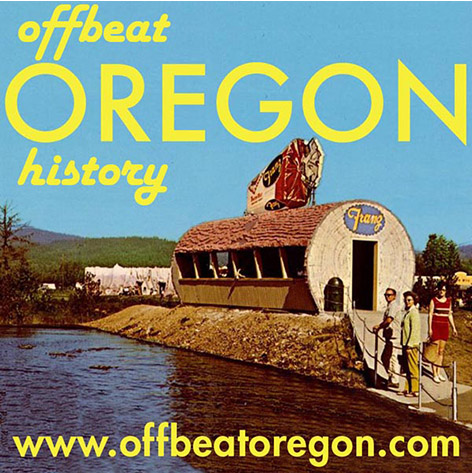AURORA MILLS, CLACKAMAS COUNTY; 1850s:
How a dead man led a wagon train to Oregon
Audio version: Download MP3 or use controls below:
|

But by the early 1850s, Keil was already thinking about moving on from Missouri. It was getting very crowded, and many of the newcomers there spoke German; so keeping his flock from the corruptions of the world was getting harder to do. Also, malaria was, in those pre-swampland-reclamation days in the Mississippi Valley, a real problem. Accordingly, Keil decided to put together a wagon train, head west, and find a new home for the colony in the clean air of the Pacific Northwest. Which, of course, led directly to that conversation with the young Cavalry officer — the first of several to urge him to turn his flock back and try another year.
Party after party of armed Sioux and other Plains Indians came to see, as word spread that this particularly large wagon train was being led by a dead man. The Indians would look respectfully at the coffin, make gestures of friendship, listen to a few hymns in German, and be on their way. And the Indians didn’t just leave the Bethel party alone — many were actively helpful. At one point, when some of the party’s livestock escaped, a group of Yakima tribe members actually drove the animals back to the wagon train. The party passed the charred remains of at least one less fortunate wagon train along the way. In the discolored iron bands and burned corpses, they saw what probably would have happened to them if not for the protective presence of young Willie. They stopped to bury and pray for the dead, and moved on.
WHEN THE PARTY arrived on the West Coast, they headed straight for the spot that Keil’s scouts had found and staked out for him. It was a beautiful spot on the banks of the Willapa River, about 20 miles inland from Willapa Bay in what today is Pacific County, Washington. Dr. Keil was not impressed. The site was certainly very remote, so it would be easy enough to prevent corrupting influences from slithering in amongst his flock; but by the same token the nearest major settlement the commune could trade with would be many arduous miles away, so there would be few opportunities to make any money. Plus, Dr. Keil found the area’s frequent gray and misty weather tiresome. His scouts had arrived during one of the area’s comparatively rare and beautiful sunny spells; now, with the wagon train in tow, he was seeing a whole different side to the place. The colonists promptly and ceremoniously laid Willie to rest in his coffin full of whiskey, and then, weary and footsore though they were, they set out immediately for a second spot that Keil’s scouts had identified as a possibility: a lovely patch of land alongside the Pudding River, with a working flour mill on it, about 10 miles southwest of Oregon City. Dr. Keil liked this spot much better. He named the new Christian commune Aurora, after his daughter. The Aurora Colony would become, on balance, possibly the most successful Christian communal experiment of the 19th century. We’ll explore more of the Aurora story in Part Two of this two-part series.
|


